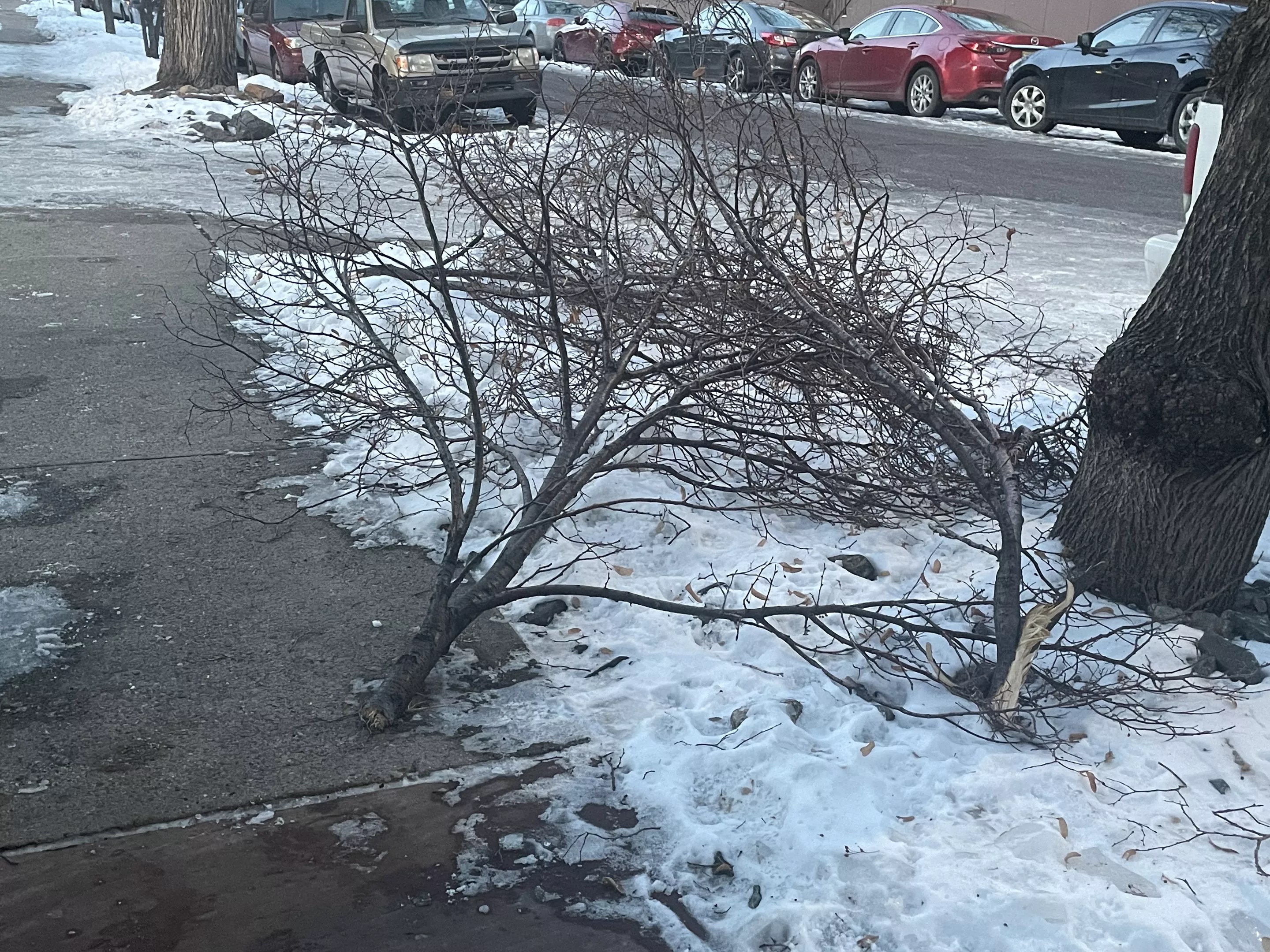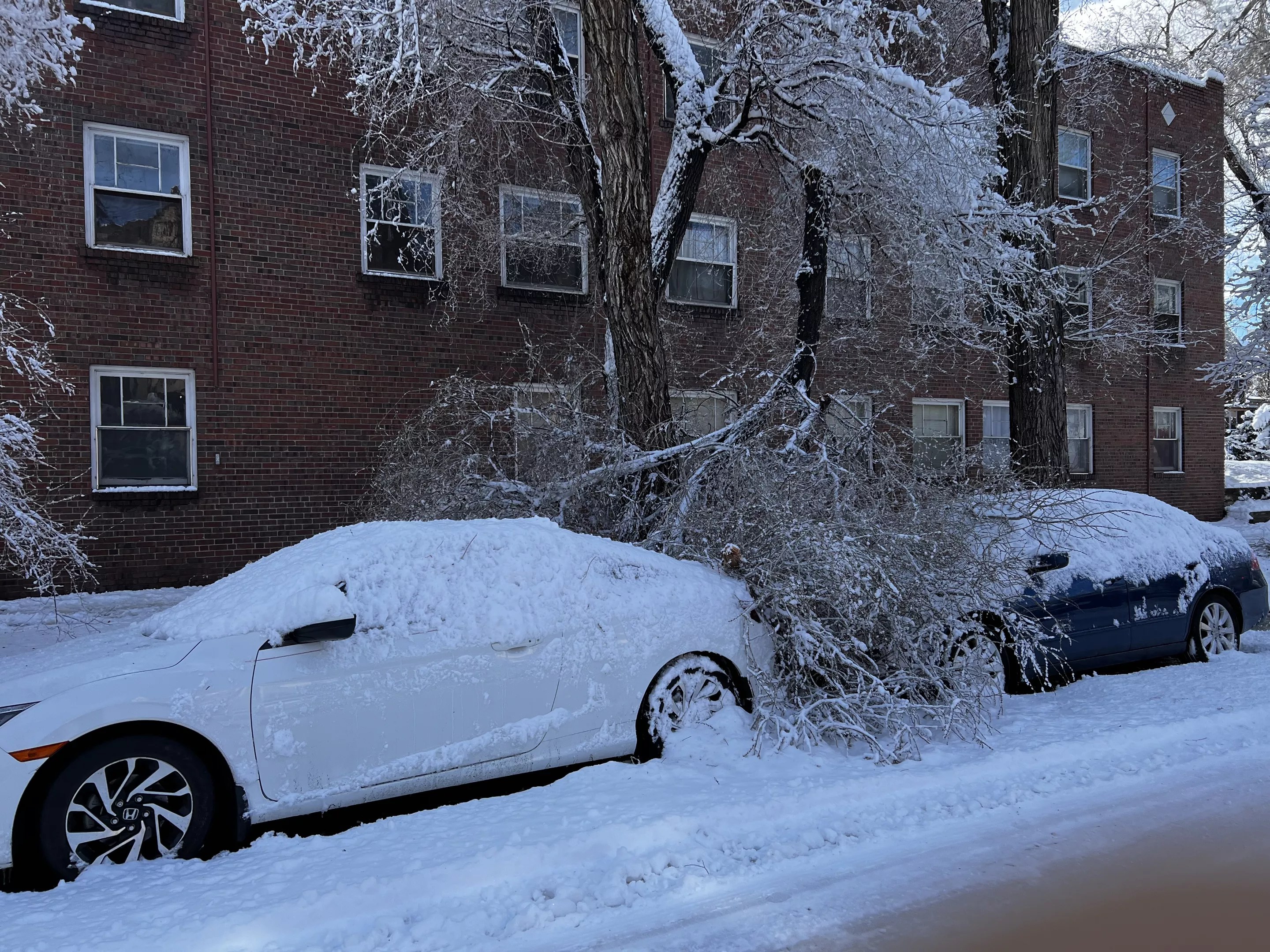
Catie Cheshire

Audio By Carbonatix
Last week’s snowstorm that blanketed Denver in 7.1 inches of snow helped to propel the city to its first drought-free status in over a year, but it also drew attention to the city’s underwhelming snow removal practices and the susceptibility of area trees to lose their branches when the snow is heavier than usual so early in the season – not to mention that no one seems to know what to do with all of the tree parts strewn about the city’s streets and sidewalks right now.
David Boswell, general manager of local tree-care business Ross Tree Company, says Mother’s Day in May is typically when heavy, high-water-content snow falls, which made this recent storm remarkable. “Normally this is our slow season, but we’ve seen an uptick now on tree assessment and trees that have fallen on houses and cars and in right-of-ways,” he says.
But who is going to clean up this mess? It turns out that in addition to being responsible for downed trees and branches on your property, residents are also required to clean up and haul away downed trees on the sidewalk or in any public right-of-way adjacent to their property. In other words, just because a branch fell in the parking space on the street in front of your house rather than in your yard doesn’t mean you’re off the hook.
“If it’s on the right-of-way adjacent to your property, you are the one who has to take care of getting it removed,” says Holly Batchelder, spokesperson for Denver Parks & Recreation. “That means either breaking it down yourself, or hiring a tree company to come break it down.”
Denver, make your New Year’s Resolution Count!
We’re $10,000 away from reaching our $50,000 year-end fundraising goal. Your support could be what pushes us over the top. If our work has kept you informed and connected this year, please consider making a contribution today.
If a property owner doesn’t clean up the downed trees, the city will eventually take care of it – and the property owner will have to foot the bill, according to Batchelder. “If there’s a tree down near you, and it’s on someone else’s property or the street or right-of-way, you can call 311 and someone will come assess the situation,” she adds.
How much will it cost? It all depends on the size of the job, when the city has to come take care of it – with higher rates for weekend and after-hours work – and the type of equipment required. The city estimates that the cost of tree debris cleanup ranges from $300 to $1,500, but they try to ease some of that sting by offering a 12-month payment plan for right-of-way work that’s billed to a property owner, Batchelder says.
Since the storm last week, the city’s forestry employees have been responding to calls to 311 about trees in public-access areas by mapping the reported locations, as well as by driving street by street to assess the damage. “In some cases, they have been able to break the trees down or move them to a spot where they aren’t blocking access, but sometimes they have been unable to remove the branches right then,” Batchelder says. “But you can see on the map by the color coding which places need a return visit to pick up the debris, or where it’s been picked up, based on the key. There are icons on the map that show downed trees or branches that are hanging over and blocking the right-of-way. Eventually, all of those dots on the map will be taken care of and turned to green.”

The City of Denver says to get on out there and break these down to four-foot, four-inch-diameter pieces.
Kyle Wagner
How long it will take for all of the downed trees to be cleaned up is hard to predict, she adds, but the map indicates that the process is well underway. The Office of the City Forester is currently short-staffed, according to its automatic email response, and so Batchelder says she hopes that people will be patient, especially considering the extremely large number of damaged trees from this storm.
“But if you see that a tree is down and that location isn’t flagged on the map, call 311 to get a dot added to it and trigger a response from the city,” she says. If the debris is adjacent to private property on the street, sidewalk or in the right-of-way, the city will remove it and then bill the property owner. “Maybe not everyone understands that in Denver, the street trees are regulated by the City Forester, but maintaining them is a shared responsibility of the property owners adjacent to those trees,” Batchelder explains.
Another option is to hire a tree company to do the heavy lifting. Ross Tree Company, for example, chips trees on-site when it can or transports trees to its lot for storage until they can be chipped. It works with Renewable Fiber, a landscape supply company, to recycle those chips and send them out for sale at landscaping stores, turn them into compost, or take them to places where they can be burned for fuel.
Boswell says the tree removal industry is unusually busy right now, with many companies booked out four to eight weeks in advance, so unexpected situations such as the one caused by the snowstorm will often incur emergency charges. According to Boswell, if a branch is removed before it falls off the tree, it costs about $175, but that price can easily triple or quadruple, particularly if removal is needed during inclement weather or dangerous conditions.
For those who want to deal with the mess themselves, cut branches into pieces no larger than four inches in diameter and no longer than four feet in length and tie them up into bundles weighing no more than fifty pounds before leaving those branches out for large-item pickup. To keep the branches from being taken to the landfill, you can drop them off at the Cherry Creek Recycling drop-off center, located near East Cherry Creek Drive South and South Quebec Street; the center is open Tuesday through Friday from 9 a.m. to 5 p.m. and Saturday from 9 a.m. to 3 p.m.
Compost customers can put branches that have been broken down into the aforementioned dimensions directly into their compost bins for collection.
In addition, through the end of January, the Denver Department of Transportation and Infrastructure is running its annual Treecycle program, which hosts expanded drop-off locations for used Christmas trees during the week and even more on weekends. Trees must be completely free of decorations. It also picks up Christmas trees during large-item pickup without requiring the typical cutting-down and bundling process.
This year, however, the “recycle” part of “Treecycle” is true only of trees taken to drop-off locations. In the past, all trees collected as part of Treecycle were turned into mulch and available to Denver residents at the Mulch Giveaway in the spring. As of 2023, trees left out as part of large-item pickup won’t be composted or made into mulch anymore, but according to Nancy Kuhn, marketing and communications manager for DOTI, the city is also accepting downed branches from the storm at all Treecycle drop-off sites, too.
In the past, the department didn’t offer large-item pickup in January except for collecting trees through Treecycle. Now, trees will be lumped in with other large items and sent to the landfill. The change was spurred by the department’s transition from providing large-item pickup every eight weeks to providing it every month starting in February 2022, after increased demand for large-item pickup was reported by customers and Denver City Council.
Boswell also encourages people to call an arborist to examine trees for structural issues and other problems that could be addressed before another snowstorm strikes, and to look for companies like his that offer free estimates. “It’s almost like dental work in a way,” Boswell says. “You want to get your cleaning done frequently.”
And you don’t have to wait until spring; in fact, winter is often the best time of year to have your trees looked at, Boswell says, because without leaves, it’s easier to see defects in the tree canopy and prune branches.
“For arborists, we love to go out and look at trees at this time of year,” Boswell adds. “You can’t always plan for everything, especially when it comes to acts of weather, but it’s good to try to mitigate things before they happen. The biggest thing is just being proactive.”